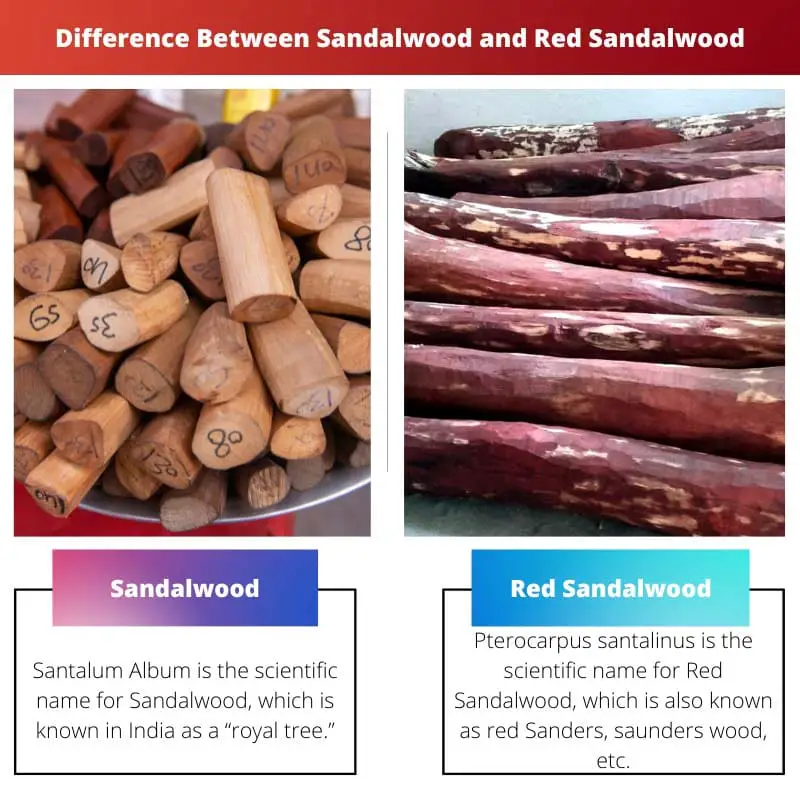The forest contains a wide diversity of trees and plants. Some of those plants, trees, and herbs are considered rare and distinctive because they are utilized to manufacture medicine, perfume, and beauty products, among other things.
Sandalwood is one of the most valuable trees we may discover in the wild. Sandalwood is a type of wood that comes from the Santalum genus of plants.
The trees are hefty, golden, and fine-grained, and they hold their aroma for years.
Key Takeaways
- Sandalwood is a fragrant, slow-growing hardwood primarily used for its essential oil and carving. At the same time, red sandalwood, also known as red sanders, is a dense, non-aromatic hardwood used for its color and durability.
- Sandalwood oil has various applications in perfumery, cosmetics, and traditional medicine, while red sandalwood is prized for high-quality furniture, musical instruments, and dye production.
- Both types of wood are valuable and sought after, but for different purposes, with sandalwood being more associated with its scent and red sandalwood with its strength and color.
Sandalwood vs Red Sandalwood
Sandalwood is a fragrant wood commonly used in incense, cosmetics, and traditional medicine. The wood is sourced from the Santalum tree. Red sandalwood, also known as Pterocarpus santalinus, is a different tree species with a red-hued wood used for its medicinal and dyeing properties.

Santalum Album is the scientific name for Sandalwood, which is known in India as a “royal tree.” It goes by several names, including Chandan, East Indian Sandalwood, etc. based on the area where it is grown or indigenous.
This parasitic tree gets its nutrition from other vegetation via haustoria (An outgrowth of a fungus or parasitic plant that absorbs nutrients from the host.) That makes it easy to grow no matter what the soil qualities are like.
The Sandalwood tree thrives as far as its supporting plant does.
Pterocarpus santalinus is the scientific name for Red Sandalwood, which is also known as red Sanders, saunders wood, etc. It is not scented as white Sandalwood, and when ripped to shreds and pulverized, it has a crimson hue.
A Red sandalwood tree is very remarkable because it takes hundreds of years to grow in width, and its super-duper aspect causes it to fall when submerged in water.
Nevertheless, it must be stored in a cool, dry location where it is shielded from direct sunlight to maintain its color.
Comparison Table
| Parameters of Comparison | Sandalwood | Red Sandalwood |
|---|---|---|
| Botanical name | Santalum Album | Pterocarpus santalinus |
| Color | White | Red |
| Status of Conservation | Vulnerable | Endangered |
| Found in | Southern India and Southeast Asia | In India, the southern parts of the Eastern Ghats, primarily in the woodland tracts of Andhra Pradesh. |
| Height | 4 meters to 10metres | 5 meters to 8metres |
What is Sandalwood?
Sandalwood is a big shrub or tree that grows well in zones 10 through 11. The majority of Sandalwood variations are indigenous to India, Hawaii, etc. even though there are over 100 varieties.
Sandalwood can develop as 10-foot-tall or trees up to 30 feet tall, according to the species and environment. They’re frequently located in low, dry mud or sandy soils.
Sandalwood trees can withstand strong winds, dryness, salt deposits, and scorching heat.
The aromatic oil of Sandalwood is extracted from the plant’s blossoms and bark. Since the organic essential oils become more potent with age, trees are picked between the ages of 10 and 30.
Fungus and germs are said to be inhibited by Sandalwood. It might help with spasms.
It also has many other benefits that make it a special tree. some of its uses are listed below:
– Sandalwood essential oil and dust are utilized in health and cosmetic products because it acts as an antibacterial and astringent, as well as a treatment for acne and eczema.
It’s used to treat breathing issues like the flu, bronchitis, and throat infection.
-It aid in the treatment of urinary tract infections (UTIs), cardiovascular illness, and liver and gallbladder issues
– Some meals contain white Sandalwood as a flavor.
-Its oil is utilized for its scent in soaps, scents, incense sticks, and pharmaceuticals.
– The exterior wood is thrown off and used to produce pendants and statues.

What is Red Sandalwood?
Red Sandalwood, also known as saunders wood, or ruby red, is a tightly controlled red-colored wood with therapeutic benefits. Red Sandalwood is in high demand in both the domestic and global markets.
The IUCN (International Union for Conservation of Nature) has classified the uncommon plant species as “near endangered” owing to overharvesting.
Red Sandalwood contains drying properties, which may be beneficial for wounds, diarrhea, and coughs. Red sandalwood, reported by The News Minute, sells for millions of dollars on the global market.
As a result, the smuggling of this endangered species is well underway. As a result, Special Task Forces were dispatched to defend the trees.
India has severe rules in place to prevent the trafficking of these trees. There are also numerous benefits of this tree which makes it a unique and endangered tree, some of its benefits are listed below:
– In alcoholic drinks, it’s employed as a flavor enhancer, it also aids in the treatment of digestive disorders and liquid retention.
– It’s possible to utilize it for “blood cleansing.”
– Pimples, dryness, and acne can all be treated with Red Sandalwood.
– Red Sandalwood is used to cure eye diseases in Ayurveda. It also contains anti-inflammatory and ant parasitic properties.

Main Differences Between Sandalwood and Red Sandalwood
- Sandalwood takes less time to grow than Red sandalwood.
- Sandalwood is aromatic whereas Red Sandalwood is non- aromatic.
- Sandal Wood is a tropical tree whereas, Red Sandal Wood is a deciduous tree.
- The soil type for Sandalwood is Slightly alkaline soi, on the other hand, the Red Sandalwood may thrive on a range of soils, including those that have been deteriorated
- Sandalwood is also utilized as a flavoring ingredient in various cuisines, while Red Sandalwood is employed in alcoholic drinks as a flavor enhancer.

- https://www.tandfonline.com/doi/abs/10.1080/00405000802125246
- https://pubs.rsc.org/en/content/articlehtml/1975/p1/p19750000186
